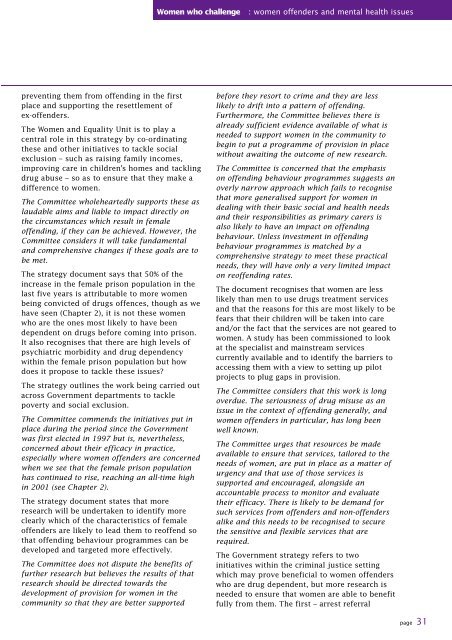Women who challenge - Nacro
Women who challenge - Nacro
Women who challenge - Nacro
- No tags were found...
Create successful ePaper yourself
Turn your PDF publications into a flip-book with our unique Google optimized e-Paper software.
<strong>Women</strong> <strong>who</strong> <strong>challenge</strong>: women offenders and mental health issuespreventing them from offending in the firstplace and supporting the resettlement ofex-offenders.The <strong>Women</strong> and Equality Unit is to play acentral role in this strategy by co-ord i n a t i n gthese and other initiatives to tackle socialexclusion – such as raising family incomes,i m p roving care in childre n ’s homes and tacklingd rug abuse – so as to ensure that they make ad i ff e rence to women.The Committee <strong>who</strong>leheartedly supports these aslaudable aims and liable to impact directly onthe circumstances which result in femaleoffending, if they can be achieved. However, theCommittee considers it will take fundamentaland comprehensive changes if these goals are tobe met.The strategy document says that 50% of theincrease in the female prison population in thelast five years is attributable to more womenbeing convicted of drugs offences, though as wehave seen (Chapter 2), it is not these women<strong>who</strong> are the ones most likely to have beendependent on drugs before coming into prison.It also recognises that there are high levels ofpsychiatric morbidity and drug dependencywithin the female prison population but howdoes it propose to tackle these issues?The strategy outlines the work being carried outacross Government departments to tacklepoverty and social exclusion.The Committee commends the initiatives put inplace during the period since the Governmentwas first elected in 1997 but is, nevertheless,concerned about their efficacy in practice,especially where women offenders are concernedwhen we see that the female prison populationhas continued to rise, reaching an all-time highin 2001 (see Chapter 2).The strategy document states that moreresearch will be undertaken to identify moreclearly which of the characteristics of femaleoffenders are likely to lead them to reoffend sothat offending behaviour programmes can bedeveloped and targeted more effectively.The Committee does not dispute the benefits offurther research but believes the results of thatresearch should be directed towards thedevelopment of provision for women in thecommunity so that they are better supportedbefore they resort to crime and they are lesslikely to drift into a pattern of offending.Furthermore, the Committee believes there isalready sufficient evidence available of what isneeded to support women in the community tobegin to put a programme of provision in placewithout awaiting the outcome of new research.The Committee is concerned that the emphasison offending behaviour programmes suggests anoverly narrow approach which fails to recognisethat more generalised support for women indealing with their basic social and health needsand their responsibilities as primary carers isalso likely to have an impact on offendingbehaviour. Unless investment in offendingbehaviour programmes is matched by acomprehensive strategy to meet these practicalneeds, they will have only a very limited impacton reoffending rates.The document recognises that women are lesslikely than men to use drugs treatment serv i c e sand that the reasons for this are most likely to befears that their children will be taken into careand/or the fact that the services are not geared towomen. A study has been commissioned to lookat the specialist and mainstream serv i c e sc u rrently available and to identify the barriers toaccessing them with a view to setting up pilotp rojects to plug gaps in pro v i s i o n .The Committee considers that this work is longoverdue. The seriousness of drug misuse as anissue in the context of offending generally, andwomen offenders in particular, has long beenwell known.The Committee urges that resources be madeavailable to ensure that services, tailored to theneeds of women, are put in place as a matter ofurgency and that use of those services issupported and encouraged, alongside anaccountable process to monitor and evaluatetheir efficacy. There is likely to be demand forsuch services from offenders and non-offendersalike and this needs to be recognised to securethe sensitive and flexible services that arerequired.The Government strategy refers to twoinitiatives within the criminal justice settingwhich may prove beneficial to women offenders<strong>who</strong> are drug dependent, but more research isneeded to ensure that women are able to benefitfully from them. The first – arrest referralpage 31
















